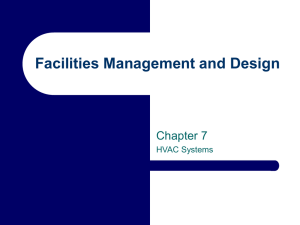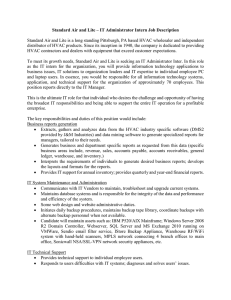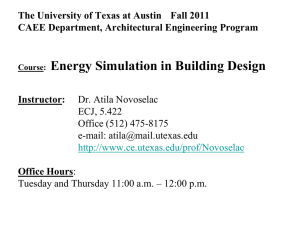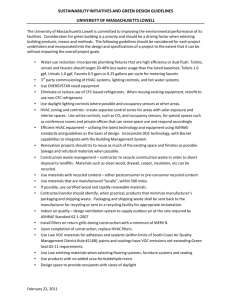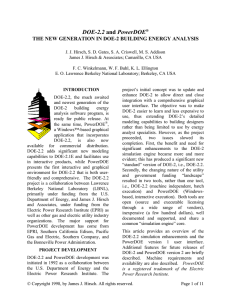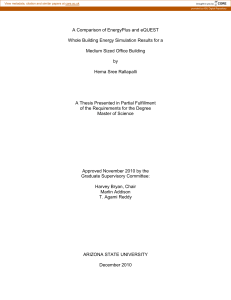383_NO20_Final_project
advertisement
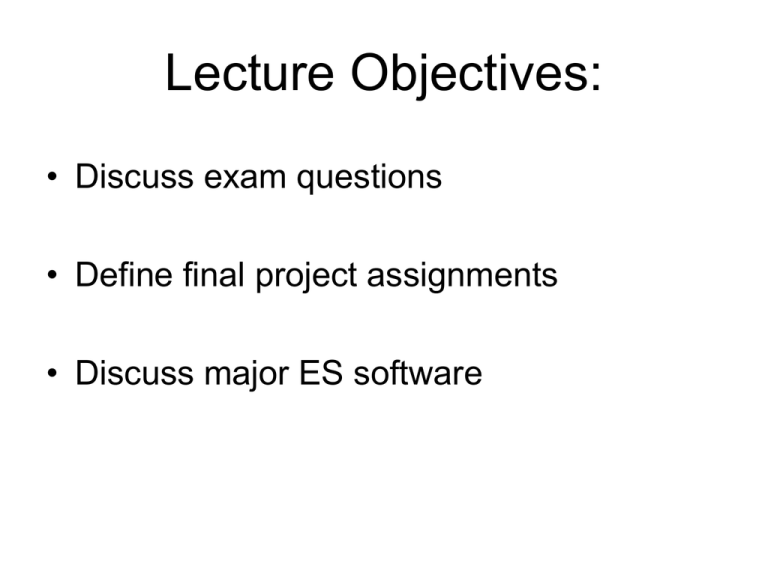
Lecture Objectives: • Discuss exam questions • Define final project assignments • Discuss major ES software Requirement for the project Email me (before Friday morning): • Final project group members • Project title • One paragraph (200-300 words) including - Project objective - Methodology - Expected results Any schematic drawing is welcome Wednesday after 2 pm and Thursday after 11 am long office hours to discuss your project Commercial Buildings Building 1) Optimization of building envelops glass area ,shading,…. 2) Effect of internal loads on energy consumption .................. Systems 1) Impact of HVAC systems 2) Design of solar system (PV or hot water) …………….. Life cycle cost analysis in each project Example of HVAC: water cooled chiller Chiller Cooling tower Water 120°F Water 52°F Building Outside air 95°F Water 100°F Water 42°F Inside 75°F Task: analyze COP for the whole year and different locations Example of HVAC thermal storage systems (in combination with a cooling machine / heat pump) Summer In the summer, the earth acts as a cooling tower. The Cooling Machine loads the loop with heat, sending warmed water to be cooled by the earth Winter In the winter, the earth acts as the boiler. The Heat Pump extracts heat from the loop, sending cooled water to be warmed by the earth. Residential buildings • It is very expensive to optimize each residential building • We optimize example buildings to develop local codes UT Solar Decathlon 2007 Test house (PRC) Home Research Lab Modeling for optimization of Home Research Lab (PSP) Energy consumption in Austin’s residential house Miscellaneous Cooling Washer Range Refrigerator 2000 (15,600 kWh) Including gas Lighting Heating Dryer Hot water See handout section Analyze impact of: • envelope • Internal loads • HVAC systems Conduct life cycle const analysis More final project topics: Software (eQUEST) based • Energy analysis of building form Integrated design course, • Any other building or building system Detail Modeling (your model) • • • • • Heat recovery systems, Attic problem, Mass transfer (moisture,…) Vented cavity walls - exam problem Green house model Your ideas… Project Grading • • • • • • • • GRADING CRITERIA (30% of your final grade): 1) Analysis approach: 60% - Modeling quality 20% - Result accuracy 20% - Result analysis 20% 2) Deliverables: 40% - Quality of the final report 25% - Quality of oral presentations 15% • Undergraduate students – Engineering report • Graduate students – Research report Project Timeline • • • • 11/11/11 – project defined and approved 11/22/11- generated preliminary results 12/01/11 - oral presentation 12/05/11 - project paper submission Structure of ES programs Graphical User Interface (GUI) Interface for input data Interface for result presentation Solver Preprocessor Preprocessor Engine ASCI file ASCI file Modeling steps • Define the domain • Analyze the most important phenomena and define the most important elements • Discretize the elements and define the connection • Write energy and mass balance equations Preprocessor Solver • Solve the equations • Present the result Postprocessor ES program Characteristic parameters • Conduction (and accumulation) solution method – finite dif (explicit, implicit), response functions • • • • • • • Time steps Meteorological data Radiation and convection models (extern. & intern.) Windows and shading Infiltration models Conduction to the ground HVAC and control models ES programs • Large variety • http://www.eere.energy.gov/buildings/tools_directory • • • • • • DOE2 eQUEST (DOE2) BLAST ESPr TRNSYS EnergyPlus (DOE2 & BLAST) eQUEST (DOE2) US Department of Energy & California utility customers • eQUEST - interface for the DOE-2 solver • DOE-2 - one of the most widely used ES program - recognized as the industry standard • eQUEST very user friendly interface • Good for life-cycle cost and parametric analyses • Not very large capabilities for modeling of different HVAC systems • Many simplified models • Certain limitations related to research application - no capabilities for detailed modeling ESPr University of Strathclyde - Glasgow, Scotland, UK • • • • Detailed models – Research program Use finite difference method for conduction Simulate actual physical systems Enable integrated performance assessments Includes daylight utilization, natural ventilation, airflow modeling CFD, various HVAC and control models • Detail model – require highly educated users • Primarily for use with UNIX operating systems TRNSYS Solar Energy Lab - University of Wisconsin • • • • • Modular system approach One of the most flexible tools available A library of components Various building models including HVAC Specialized for renewable energy and emerging technologies • User must provide detailed information about the building and systems • Not free EnergyPlus U S Department of Energy • Newest generation building energy simulation program ( BLAST + DOE-2) • Accurate and detailed • Complex modeling capabilities • Large variety of HVAC models • Some integration wit the airflow programs Zonal models and CFD • Detail model – require highly educated users • Very modest interface • Third party interface – very costly
